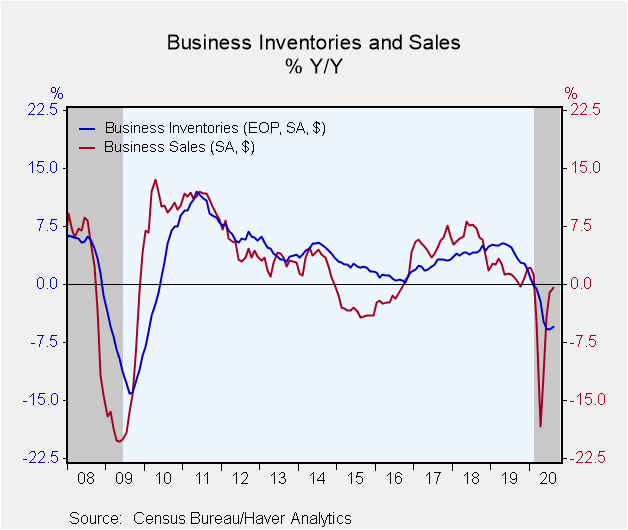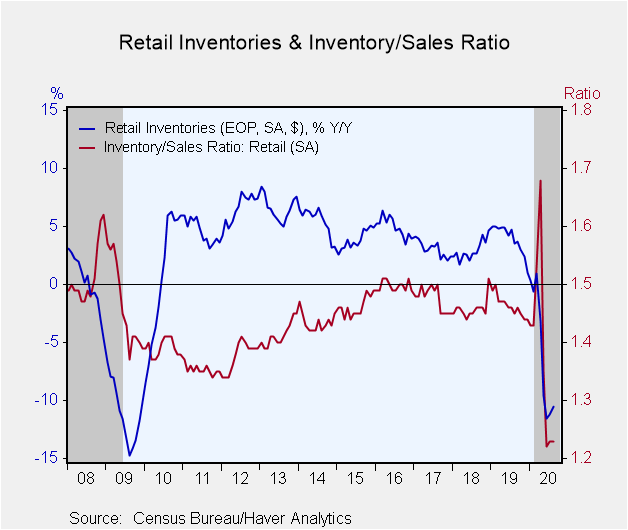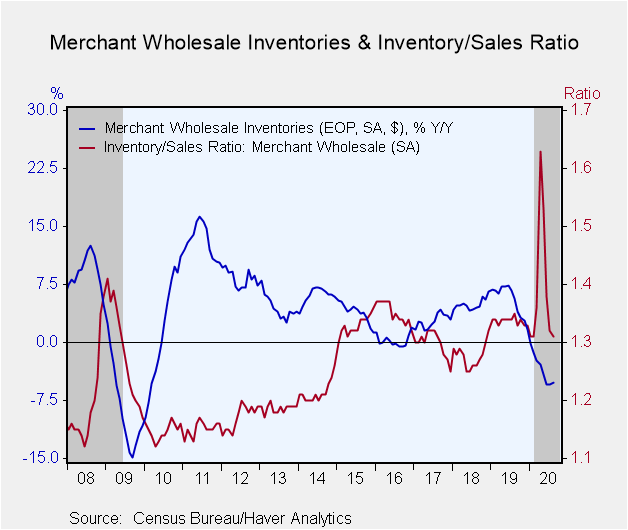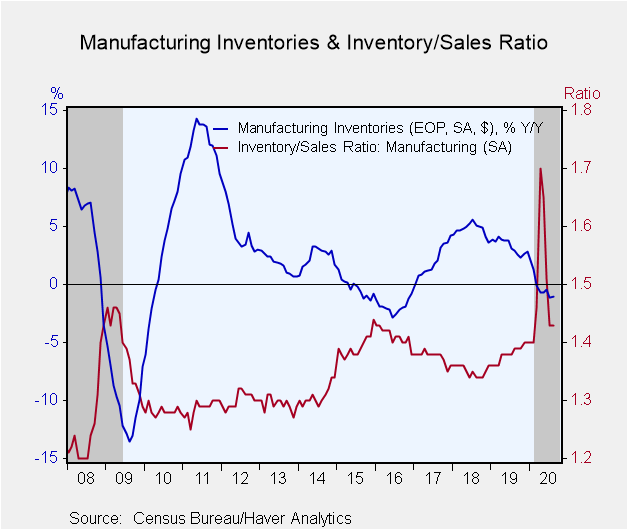 Global| Oct 16 2020
Global| Oct 16 2020U.S. Business Inventories Rise In August Along With Sales
by:Tom Moeller
|in:Economy in Brief
Summary
• Business inventory accumulation accelerates. • Sales growth eases. • Inventory-to-sales ratio falls further to six-year low. Total business inventories rose 0.3% (-5.5% y/y) during August following an unrevised 0.1% uptick in July. [...]
• Business inventory accumulation accelerates.
• Sales growth eases.
• Inventory-to-sales ratio falls further to six-year low.
Total business inventories rose 0.3% (-5.5% y/y) during August following an unrevised 0.1% uptick in July. This is only the second increase since the beginning of the year. Total business sales gained 0.6% (-0.4% y/y) following a 3.4% jump in July. The inventory-to-sales (I/S) ratio dipped to 1.32. In April, the I/S ratio equaled a 27-year high of 1.67.
Retail inventories increased 0.4% in August (-10.5% y/y). Auto inventories, which comprise roughly 30% of retail inventories, grew 0.3% (-24.7% y/y). Non-auto retail inventories gained 0.5% (-2.6% y/y). General merchandise inventories, the second largest retail sector, rose 0.8% (-5.1% y/y). In the department store sector, a subset of general merchandise, inventories surged 2.4% (-15.4% y/y). Wholesale inventories rose 0.4% (-5.2% y/y) while factory sector inventories held steady ( -1.0% y/y).
Retail sales increased 0.2% (5.4% y/y) as non-auto sales held steady. The advanced retail sales data for September was released today and indicated a 1.9% jump (8.2% y/y). Wholesale sector sales surged 1.4% (-2.3% y/y while factory shipments improved 0.3% (-3.9% y/y).
The inventory-to-sales ratio in the retail sector held steady at 1.23 versus June's record low of 1.22 (data date back to 1967). The non-auto I/S ratio rose slightly to 1.12 from its record low of 1.11 in July. The wholesale I/S ratio edged lower to 1.31 and the factory sector ratio held steady at 1.43.
The manufacturing and trade, industrial production and international trade data are in Haver's USECON database. Detailed industrial production data can be found in the IP database
| Manufacturing & Trade | Aug | Jul | Jun | Aug Y/Y | 2019 | 2018 | 2017 |
|---|---|---|---|---|---|---|---|
| Business Inventories (% chg) | 0.3 | 0.1 | -1.1 | -5.5 | 1.9 | 4.9 | 3.2 |
| Retail | 0.4 | 1.2 | -2.7 | -10.5 | 1.0 | 4.6 | 2.4 |
| Retail excl. Motor Vehicles | 0.5 | 0.6 | -0.9 | -2.6 | 1.9 | 3.7 | 2.2 |
| Merchant Wholesalers | 0.4 | -0.2 | -1.3 | -5.2 | 1.7 | 6.5 | 3.0 |
| Manufacturing | 0.0 | -0.6 | 0.5 | -1.0 | 2.8 | 3.6 | 4.2 |
| Business Sales (% chg) | |||||||
| Total | 0.6 | 3.4 | 8.6 | -0.4 | 1.6 | 5.9 | 5.3 |
| Retail | 0.2 | 0.8 | 6.9 | 5.4 | 3.4 | 4.2 | 4.6 |
| Retail excl. Motor Vehicle | 0.0 | 1.2 | 6.3 | 5.5 | 3.3 | 5.1 | 4.9 |
| Merchant Wholesalers | 1.4 | 4.8 | 9.0 | -2.3 | 0.6 | 6.8 | 6.7 |
| Manufacturing | 0.3 | 4.7 | 10.0 | -3.9 | 1.0 | 6.6 | 4.7 |
| I/S Ratio | |||||||
| Total | 1.32 | 1.33 | 1.37 | 1.39 | 1.39 | 1.36 | 1.38 |
| Retail | 1.23 | 1.23 | 1.22 | 1.45 | 1.46 | 1.46 | 1.48 |
| Retail excl. Motor Vehicles | 1.12 | 1.11 | 1.12 | 1.21 | 1.23 | 1.22 | 1.24 |
| Merchant Wholesalers | 1.31 | 1.32 | 1.38 | 1.35 | 1.34 | 1.28 | 1.30 |
| Manufacturing | 1.43 | 1.43 | 1.51 | 1.39 | 1.38 | 1.35 | 1.38 |
Tom Moeller
AuthorMore in Author Profile »Prior to joining Haver Analytics in 2000, Mr. Moeller worked as the Economist at Chancellor Capital Management from 1985 to 1999. There, he developed comprehensive economic forecasts and interpreted economic data for equity and fixed income portfolio managers. Also at Chancellor, Mr. Moeller worked as an equity analyst and was responsible for researching and rating companies in the economically sensitive automobile and housing industries for investment in Chancellor’s equity portfolio. Prior to joining Chancellor, Mr. Moeller was an Economist at Citibank from 1979 to 1984. He also analyzed pricing behavior in the metals industry for the Council on Wage and Price Stability in Washington, D.C. In 1999, Mr. Moeller received the award for most accurate forecast from the Forecasters' Club of New York. From 1990 to 1992 he was President of the New York Association for Business Economists. Mr. Moeller earned an M.B.A. in Finance from Fordham University, where he graduated in 1987. He holds a Bachelor of Arts in Economics from George Washington University.










